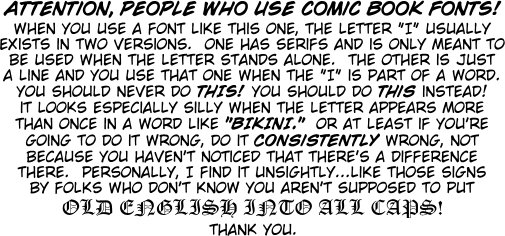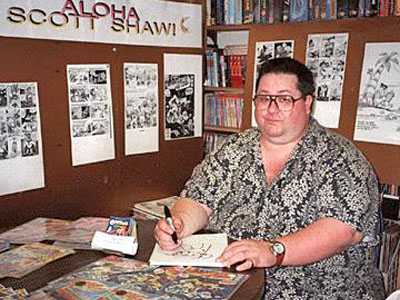Mike Guerrero (who has his own weblog here) writes, in reference to my previous item…
I think what bothers me is the fact that if you work on a comic book, there's usually a box of credits that list who did what, i.e. pencils, inks, and even breakdowns and finishes. Articles in newspapers will usually list others who contributed along with the actual writer. But a comic strip usually has just one name, leading one to believe that one person thought up the idea for the strip, drew it, inked it, and lettered it. I don't really care if the strip was a team effort or not, but there is a slight case of misrepresentation going on here. Probably none of those artists mentioned would deny that they don't have help creating their strips. But they probably don't make too much noise about it, either. When the strip says "Mother Goose and Grimm by Mike Peters" shouldn't it be true? Or should there be an "executive producer" credit instead?
I'm all for honesty, but let's remember that media credits are not always complete or (sometimes) even accurate. I've written for comedians who went on The Tonight Show and did jokes I thought of, and no one stopped to say, "Oh, by the way, Mark Evanier thought of that." Major motion pictures often have many uncredited writers. On a TV show, five producers and eight story editors may have pitched in to rewrite the script and all contributed material that got on the air…but the "Written by" credit went to the first writer. Almost all forms have some tradition of ghost writing or of the credited individual receiving some unbilled help. When I see something like "Mother Goose and Grimm by Mike Peters," I don't presume it means that every word and brushstroke is Mike's work. I think it means that Mike produces the strip, and writes and draws most of it. "Executive producer" seems less accurate to me because it implies he's not writing or drawing it, and he is. For the most part.
That said, there have been strips thay were so totally the work of a ghost that it has seemed wrong to me, if not as a matter of historical record then because it looked like some guy was getting screwed. In some cases though, it hasn't seemed to bother the anonymous guy and I can think of at least one instance when he actually preferred it that way. His attitude was that he was drawing in someone else's style and subordinating his viewpoint, and he didn't want his name associated with the work in question. He only wanted his name on work that he felt was truly his.
For what it's worth, I've ghost-written for a few newspaper strips, more for fun (and to help out a friend in need) than as a job. It didn't bother me that my name was absent. Strips are cramped for space without having to cram in extra names, and for some, full credits would mean four or five names. (Supposedly at one point, the Napoleon and Uncle Elby strip was being written by two people and drawn by six others.) Since not all contributions are equal, true accuracy would require that you not just list names and that you differentiate those who did a lot from a little. For example, Milton Caniff created Steve Canyon and always wrote it. He'd have Frank Engli (and later, Shel Dorf) letter the strip, then someone like Dick Rockwell would pencil the whole strip and ink everything but the main characters. Then Caniff would ink main characters, touch up the rest of the strip and sometimes redo whole panels. I'm not sure how you'd explain all that in tiny credits and also make clear that Caniff was the auteur.
Lastly, even comic book credits do not always tell the whole story about who did what. Background inkers are frequently not in that credit box, and many artists occasionally have an uncredited friend pitch in and help them meet a deadline. Back before I did the business an enormous favor (for which I have never been properly thanked) and gave up drawing, I sometimes did anonymous art assists on comics. When I look back on those stories today, I'm not entirely sure what I did. Still, I'm pretty sure none of it was significant enough to warrant diminishing the credit of the guy who did the vast majority of the job.


